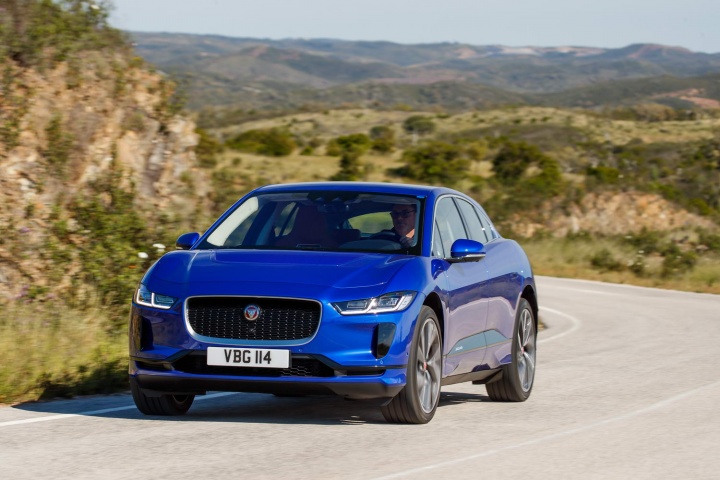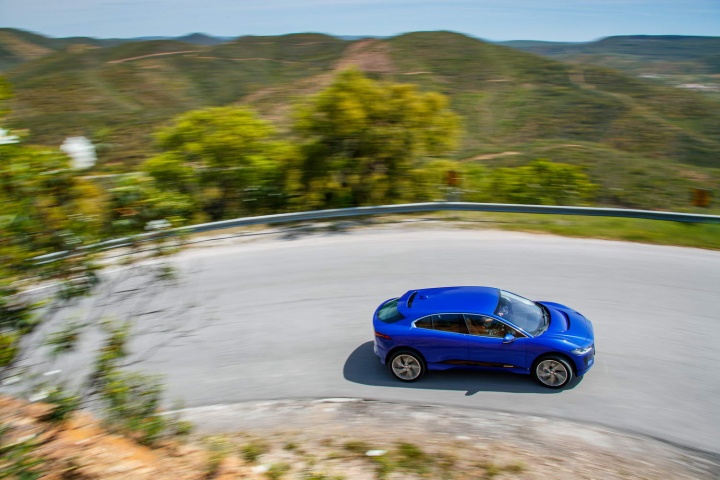The Jaguar I-Pace is not only the company's first fully electric vehicle, but it is also the first serious alternative to Tesla on the market - previously the only electric vehicle option with a longer-than-average driving range. Should Jaguar's competitors be worried? We think so.
In the metal
The new I-Pace isn't what you might expect from Jaguar, nor is it conventional looking. Thanks to its lack of a traditional transmission system and the location of the battery beneath the cabin, Jaguar's designers were able to stretch out the wheelbase to maximise interior space. Measuring in at 4,682mm long, it's in between the Jaguar E-Pace and F-Pace, but lower and wider than both. Add to that the option of wheel sizes of up to 22 inches in diameter and it's easy to see how the I-Pace doesn't exactly conform to the usual SUV template.
The designers have cleverly added several aerodynamic tweaks to help the I-Pace cut through the air more cleanly and extend the driving range a little farther. A closer look at that signature oval Jaguar grille, for example, shows a neat channel along its top that feeds air through to exit in the bonnet vent. Active vanes behind the grille also open and close depending on how much cooling is required. This 'S-duct' of sorts not only improves the aerodynamic efficiency of the front, but subsequently creates a low-pressure area in front of the windscreen to help airflow over the car further.
Aerodynamics also dictates a sharp, cut-off rear end. Look closer and you'll notice the lack of a rear wiper; instead, Jaguar fits the I-Pace with hydrophobic glass that water and dirt streams off, helped along the way by a nifty roof spoiler. Other aero-optimised features include door handles that retract flush into the doors, like on the Range Rover Velar. Unconventional its silhouette may be, but there's still plenty to tell you that this is a Jaguar. Slim but wide rear lights ape those of the sleek F-Type Coupe while the fronts have a feline-like appearance that is common across much of the Jaguar range.
Just like the ultramodern exterior, inside, the I-Pace doesn't disappoint. We're used to seeing a high standard of finish from Jaguar nowadays, but it's clear that the company has upped its game for this car. There are swathes of leather and a choice of traditional wood inserts or a more modern carbon fibre effect, with some bright touches of metallic to lift the appearance. Unsurprisingly for a new EV, the dashboard is an almost entirely digital affair, and it operates far quicker to inputs than in some of Jaguar's more recent models. The menu system itself is busy, with an abundance of submenus, but most of the primary controls that you're more likely to use frequently are housed in the lower section within easy reach.
Those sitting in the rear get to enjoy adequate levels of legroom, but unlike some electric vehicles, the floor in the back isn't completely flat. There is a small central hump for the electrical plumbing, though it isn't as prominent as a traditional transmission tunnel in other SUVs. From a practical perspective, the I-Pace scores well, with decently-sized door bins, a 10-litre central storage compartment and a big glovebox. Cargo volume in the boot starts at 656 litres and can swell to 1,453 when you tumble the rear seats forward. An additional front boot (something Jaguar engineers refer to as the 'froot'), provides 27 litres of space, just the right size to carry your charging cables.
Driving it
Where the I-Pace trumps so many other electric vehicles in the market at present is its high capacity 90kWh battery. Jaguar claims it's good enough to deliver a driving range of up to 480 kilometres during WTLP testing conditions, which is as close to real-world driving as current standards get. We certainly never experienced anything close to range anxiety during an extensive and less than economic driving route.
Performance is quite good, helped along by a healthy 696Nm of torque that is available from rest. The I-Pace will show most other normal cars a clean set of heels, with the 0-100km/h dash taking just 4.8 seconds. Sure, a Tesla Model S is faster, but just how fast do you need to get to the next red light?
Noise levels inside remain low even at motorway cruising speeds. Only small amounts of wind noise penetrate that lovely interior. An additional noise cancelling system can offset the noise from the powertrain if so desired. Alternatively, Jaguar has synthesised a dynamic sound that enhances the experience when driving with greater enthusiasm.
On flowing roads and carrying a bit of speed, the I-Pace remains fun to drive and has great composure. We found the ride from the air suspension on the larger 22-inch wheels just a little too floaty on the motorway, but it worked well through the corners. Those largest of diameter wheels have enough meat on the tyre sidewalls so as not to adversely affect the car's comfort levels. That said, we preferred how the car performed on the 20-inch wheels.
The air suspension also brings with it the ability to raise the ride height should you want to partake in some light off-roading. It is an SUV after all. We took on some steep ascents and even a small river crossing without any worry. Back on road, the air suspension does smooth out the rougher surfaces, too. However, we didn't get to sample the normal suspension on the same roads.
The steering and agility are on a par with how we would expect a sportier SUV to perform, and the low centre of gravity that the battery positioning brings is also helpful. The I-Pace is claimed to have a perfect 50/50 weight balance, with the drive out of the corners proving smooth and even thanks to its all-wheel-drive transmission. Tipping the scales at 2,208kg, the I-Pace hides its mass on the move very well.
Pick-up from the electric motors on each axle is lightning fast and as quick as it is to get away from the traffic lights, it can roll on speed in equally impressive amounts. With both motors working, the I-Pace delivers 400hp. Drivers can also utilise the Jaguar's ability to offer one-pedal driving thanks to its strong regenerative braking. Two settings are available, with the higher providing enough regenerative power to leave you almost never needing to touch the brake pedal. Interestingly, there is no coasting function, as is common with many EVs.
On the topic of charging, Jaguar claims that it can recharge from 0- to 80 per cent capacity in 40 minutes with a 100kW DC rapid charger, but it's worth noting that the public charger network in Ireland only supplies up to 50kW of DC at present. If you get a 7kW wall box charger installed at home or work, it will replenish the battery up to 80 per cent capacity from empty in 10 hours. With upwards of a 400-kilometre range, overnight charging on a home unit should be enough for most. Owners will also be able to schedule timed charging if they can avail of an off-peak or night rate tariff.
What you get for your money
Electric vehicles fall under many of the same rules as other forms of technology; if you want to get the good stuff early on, it's going to cost you. With a starting price of €84,085 after you factor in the various grants that accompany it, the I-Pace isn't exactly cheap. But take a longer-term view of how little it should cost you over several years, and it makes for a more appealing case.
In total there will be four specification grades to choose from, but one of those is the range-topping 'First Edition', which costs €112,310 (after grants). With that, you effectively get everything thrown into the deal, but if toys aren't your thing then settling for the cheaper I-Pace S should suffice, and you won't get any less driving range.
The I-Pace S gets as standard, 18-inch wheels, LED headlights, heated door mirrors, semi-powered front seats, the Touch Pro Duo and 12.3-inch driver display, all the smartphone connectivity (with Apple CarPlay due to roll out soon after launch), cruise control, traffic sign recognition with adaptive speed limiter function, lane keep assist, reversing camera and park assist. The I-Pace SE will be priced at €93,380 and the higher spec HSE at €100,405.
Summary
The Jaguar I-Pace is the first serious battery electric vehicle from a premium manufacturer, and it sets the bar high. Not only is it modern enough to appeal to early adopters, but it's also cool enough to rival Tesla and offers a more complete and well-presented package. It feels like it's worth the money it costs, in essence. But the main thing is that it appears capable of delivering a useful range in a car that's also great to drive.






















































